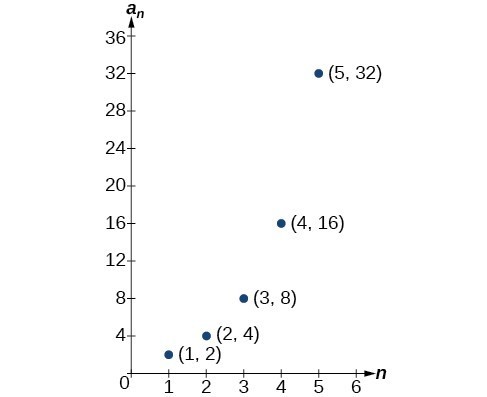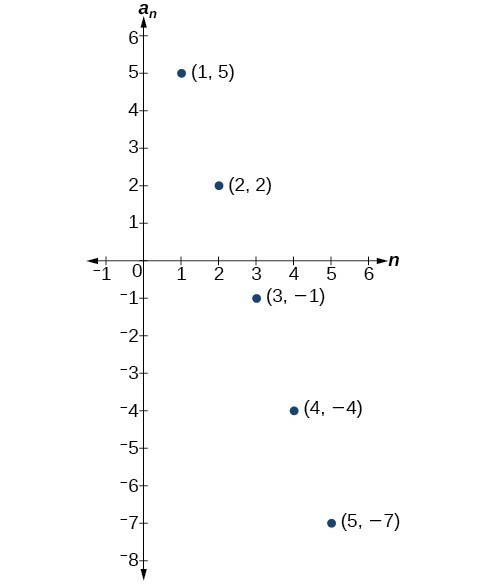Learning Objectives
- Write the terms of a sequence defined by an explicit formula
- Write the formula for the nth term of a sequence
- Find the terms of an alternating sequence
![]()
One way to describe an ordered list of numbers is as a sequence. A sequence is a function whose domain is a subset of the counting numbers. The sequence established by the number of hits on the website is
[latex]\left\{2,4,8,16,32,\dots \right\}[/latex].
The ellipsis (…) indicates that the sequence continues indefinitely. Each number in the sequence is called a term. The first five terms of this sequence are 2, 4, 8, 16, and 32.
Listing all of the terms for a sequence can be cumbersome. For example, finding the number of hits on the website at the end of the month would require listing out as many as 31 terms. A more efficient way to determine a specific term is by writing a formula to define the sequence.
One type of formula is an explicit formula, which defines the terms of a sequence using their position in the sequence. Explicit formulas are helpful if we want to find a specific term of a sequence without finding all of the previous terms. We can use the formula to find the [latex]n\text{th}[/latex] term of the sequence, where [latex]n[/latex] is any positive number. In our example, each number in the sequence is double the previous number, so we can use powers of 2 to write a formula for the [latex]n\text{th}[/latex] term.

The first term of the sequence is [latex]{2}^{1}=2[/latex], the second term is [latex]{2}^{2}=4[/latex], the third term is [latex]{2}^{3}=8[/latex], and so on. The [latex]n\text{th}[/latex] term of the sequence can be found by raising 2 to the [latex]n\text{th}[/latex] power. An explicit formula for a sequence is named by a lower case letter [latex]a,b,c..[/latex]. with the subscript [latex]n[/latex]. The explicit formula for this sequence is
[latex]{a}_{n}={2}^{n}[/latex].
Now that we have a formula for the [latex]n\text{th}[/latex] term of the sequence, we can answer the question posed at the beginning of this section. We were asked to find the number of hits at the end of the month, which we will take to be 31 days. To find the number of hits on the last day of the month, we need to find the 31st term of the sequence. We will substitute 31 for [latex]n[/latex] in the formula.
[latex]\begin{array}{l}{a}_{31}={2}^{31}\hfill \\ \text{ }=\text{2,147,483,648}\hfill \end{array}[/latex]
If the doubling trend continues, the company will get [latex]\text{2,147,483,648}[/latex] hits on the last day of the month. That is over 2.1 billion hits! The huge number is probably a little unrealistic because it does not take consumer interest and competition into account. It does, however, give the company a starting point from which to consider business decisions.
Another way to represent the sequence is by using a table. The first five terms of the sequence and the [latex]n\text{th}[/latex] term of the sequence are shown in the table.
| [latex]n[/latex] | 1 | 2 | 3 | 4 | 5 | [latex]n[/latex] |
| [latex]n\text{th}[/latex] term of the sequence, [latex]{a}_{n}[/latex] | 2 | 4 | 8 | 16 | 32 | [latex]{2}^{n}[/latex] |
Graphing provides a visual representation of the sequence as a set of distinct points. We can see from the graph below that the number of hits is rising at an exponential rate. This particular sequence forms an exponential function.

Lastly, we can write this particular sequence as
[latex]\left\{2,4,8,16,32,\dots ,{2}^{n},\dots \right\}[/latex].
A sequence that continues indefinitely is called an infinite sequence. The domain of an infinite sequence is the set of counting numbers. If we consider only the first 10 terms of the sequence, we could write
[latex]\left\{2,4,8,16,32,\dots ,{2}^{n},\dots ,1024\right\}[/latex].
This sequence is called a finite sequence because it does not continue indefinitely.
A General Note: Sequence
A sequence is a function whose domain is the set of positive integers. A finite sequence is a sequence whose domain consists of only the first [latex]n[/latex] positive integers. The numbers in a sequence are called terms. The variable [latex]a[/latex] with a number subscript is used to represent the terms in a sequence and to indicate the position of the term in the sequence.
[latex]{a}_{1},{a}_{2},{a}_{3},\dots ,{a}_{n},\dots[/latex]
We call [latex]{a}_{1}[/latex] the first term of the sequence, [latex]{a}_{2}[/latex] the second term of the sequence, [latex]{a}_{3}[/latex] the third term of the sequence, and so on. The term [latex]{a}_{n}[/latex] is called the [latex]n\text{th}[/latex] term of the sequence, or the general term of the sequence. An explicit formula defines the [latex]n\text{th}[/latex] term of a sequence using the position of the term. A sequence that continues indefinitely is an infinite sequence.
Q & A
Does a sequence always have to begin with [latex]{a}_{1}?[/latex]
No. In certain problems, it may be useful to define the initial term as [latex]{a}_{0}[/latex] instead of [latex]{a}_{1}[/latex]. In these problems, the domain of the function includes 0.
How To: Given an explicit formula, write the first [latex]n[/latex] terms of a sequence.
- Substitute each value of [latex]n[/latex] into the formula. Begin with [latex]n=1[/latex] to find the first term, [latex]{a}_{1}[/latex].
- To find the second term, [latex]{a}_{2}[/latex], use [latex]n=2[/latex].
- Continue in the same manner until you have identified all [latex]n[/latex] terms.
Example: Writing the Terms of a Sequence Defined by an Explicit Formula
Write the first five terms of the sequence defined by the explicit formula [latex]{a}_{n}=-3n+8[/latex].
Try It
Write the first five terms of the sequence defined by the explicit formula [latex]{t}_{n}=5n - 4[/latex].
Investigating Explicit Formulas
We’ve learned that sequences are functions whose domain is over the positive integers. This is true for other types of functions, including some piecewise functions. Recall that a piecewise function is a function defined by multiple subsections. A different formula might represent each individual subsection.
How To: Given an explicit formula for a piecewise function, write the first [latex]n[/latex] terms of a sequence
- Identify the formula to which [latex]n=1[/latex] applies.
- To find the first term, [latex]{a}_{1}[/latex], use [latex]n=1[/latex] in the appropriate formula.
- Identify the formula to which [latex]n=2[/latex] applies.
- To find the second term, [latex]{a}_{2}[/latex], use [latex]n=2[/latex] in the appropriate formula.
- Continue in the same manner until you have identified all [latex]n[/latex] terms.
Example: Writing the Terms of a Sequence Defined by a Piecewise Explicit Formula
Write the first six terms of the sequence.
[latex]{a_{n}}=\begin{cases}n^{2} \hfill& \text{if }n\text{ is not divisible by 3} \\ \frac{n}{3} \hfill& \text{if }n\text{ is divisible by 3}\end{cases}[/latex]
Try It
Write the first six terms of the sequence.
[latex]{a_{n}}=\begin{cases}2n^{3} \hfill& \text{if }n\text{ is odd} \\ \frac{5n}{2} \hfill& \text{if }n\text{ is even}\end{cases}[/latex]
Finding an Explicit Formula
Thus far, we have been given the explicit formula and asked to find a number of terms of the sequence. Sometimes, the explicit formula for the [latex]n\text{th}[/latex] term of a sequence is not given. Instead, we are given several terms from the sequence. When this happens, we can work in reverse to find an explicit formula from the first few terms of a sequence. The key to finding an explicit formula is to look for a pattern in the terms. Keep in mind that the pattern may involve alternating terms, formulas for numerators, formulas for denominators, exponents, or bases.
How To: Given the first few terms of a sequence, find an explicit formula for the sequence.
- Look for a pattern among the terms.
- If the terms are fractions, look for a separate pattern among the numerators and denominators.
- Look for a pattern among the signs of the terms.
- Write a formula for [latex]{a}_{n}[/latex] in terms of [latex]n[/latex]. Test your formula for [latex]n=1,\text{ }n=2[/latex], and [latex]n=3[/latex].
Example: Writing an Explicit Formula for the nth Term of a Sequence
Write an explicit formula for the [latex]n\text{th}[/latex] term of each sequence.
- [latex]\left\{-\frac{2}{11},\frac{3}{13},-\frac{4}{15},\frac{5}{17},-\frac{6}{19},\dots \right\}[/latex]
- [latex]\left\{-\frac{2}{25}\text{,}-\frac{2}{125}\text{,}-\frac{2}{625}\text{,}-\frac{2}{3\text{,}125}\text{,}-\frac{2}{15\text{,}625}\text{,}\dots \right\}[/latex]
- [latex]\left\{{e}^{4}\text{,}{e}^{5}\text{,}{e}^{6}\text{,}{e}^{7}\text{,}{e}^{8}\text{,}\dots \right\}[/latex]
Try It
Write an explicit formula for the [latex]n\text{th}[/latex] term of the sequence.
[latex]\{9;−81,729;−6,561;59,049\}[/latex]
Try It
Write an explicit formula for the [latex]n\text{th}[/latex] term of the sequence.
Try It
Write an explicit formula for the [latex]n\text{th}[/latex] term of the sequence.
Investigating Alternating Sequences
Sometimes sequences have terms that are alternate. In fact, the terms may actually alternate in sign. The steps to finding terms of the sequence are the same as if the signs did not alternate. However, the resulting terms will not show increase or decrease as [latex]n[/latex] increases. Let’s take a look at the following sequence.
Notice the first term is greater than the second term, the second term is less than the third term, and the third term is greater than the fourth term. This trend continues forever. Do not rearrange the terms in numerical order to interpret the sequence.
How To: Given an explicit formula with alternating terms, write the first [latex]n[/latex] terms of a sequence.
- Substitute each value of [latex]n[/latex] into the formula. Begin with [latex]n=1[/latex] to find the first term, [latex]{a}_{1}[/latex]. The sign of the term is given by the [latex]{\left(-1\right)}^{n}[/latex] in the explicit formula.
- To find the second term, [latex]{a}_{2}[/latex], use [latex]n=2[/latex].
- Continue in the same manner until you have identified all [latex]n[/latex] terms.
Example: Writing the Terms of an Alternating Sequence Defined by an Explicit Formula
Write the first five terms of the sequence.
Q & A
In Example: Writing the Terms of an Alternating Sequence Defined by an Explicit Formula, does the (–1) to the power of [latex]n[/latex] account for the oscillations of signs?
Yes, the power might be [latex]n,n+1,n - 1[/latex], and so on, but any odd powers will result in a negative term, and any even power will result in a positive term.
Try It
Write the first five terms of the sequence:
Candela Citations
- Revision and Adaptation. Provided by: Lumen Learning. License: CC BY: Attribution
- College Algebra. Authored by: Abramson, Jay et al.. Provided by: OpenStax. Located at: http://cnx.org/contents/9b08c294-057f-4201-9f48-5d6ad992740d@5.2. License: CC BY: Attribution. License Terms: Download for free at http://cnx.org/contents/9b08c294-057f-4201-9f48-5d6ad992740d@5.2
- Question ID 5846, 5823. Authored by: Webwork-Rochester. License: CC BY: Attribution. License Terms: IMathAS Community License CC-BY + GPL
- Question ID 5805, 5806. Authored by: David Lippman. License: CC BY: Attribution. License Terms: IMathAS Community License CC-BY + GPL
- Precalculus. Authored by: OpenStax College. Provided by: OpenStax. Located at: http://cnx.org/contents/fd53eae1-fa23-47c7-bb1b-972349835c3c@5.175:1/Preface. License: CC BY: Attribution


 So we know that the fraction is negative, the numerator is 2, and the denominator can be represented by [latex]{5}^{n+1}[/latex].
So we know that the fraction is negative, the numerator is 2, and the denominator can be represented by [latex]{5}^{n+1}[/latex].
